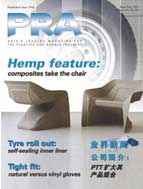 |
 |
E-News Update July 2011 |
LEAD FEATURE |
COMPANY NEWS |
MATERIALS NEWS |
MACHINERY NEWS |
INJECTION MOULDING ASIA |
PRA June-July 2011 Electronic Issue Still Available |
![]() Injection Moulding Asia
Injection Moulding Asia
Speed to market for batteries for electric vehicles
B
atteries are the key technology for the electromobility of the future. As such over the next five years, German company BASF will be investing a three-digit million euro sum in R&D and the production of battery materials. In the US, Dow Chemical has set up a joint venture with Japanese Ube Industries to make formulated electrolytes for lithium-ion batteries.The Dow/Ube 50-50 joint venture known as Advanced Electrolyte Technologies plans to set up its first facility at Dow's Midland headquarters, with start-up scheduled in 2012. Its target market will be advanced batteries for electric/hybrid vehicles and power generation.
As for BASF, part of its investment is being channelled into the construction of a production plant for advanced cathode materials in Elyria, Ohio.
This new facility with an investment volume of more than US$50 million is scheduled to supply the market with cathode materials for the production of high-performance lithium-ion batteries from mid-2012.
In addition to innovative materials for cathodes, BASF has recently also entered the field of electrolyte development. High-quality tailored electrolytes are essential for battery performance. As well as developing materials for lithium-ion batteries, which include solutions for anodes and separators, BASF is also researching future battery concepts such as lithium-sulphur or lithium-air.
To compensate for the additional battery weight of about 200 kg and allow for an acceptable driving range, the weight of electric vehicles must be reduced through lightweight construction components. This naturally places new demands on the materials, including completely new properties in terms of temperature stability, electromagnetic screening and fire resistance. Although plastics already contribute greatly to vehicular weight savings when incorporated in the chassis, interior and engine compartment, further multifunctional lightweight construction concepts are needed. For example, BASF is working on fast-curing epoxy, PU and polyamide resins for fibre-reinforced composites to be used in the manufacture of lightweight vehicle bodies.
These materials can provide further weight savings of up to 100 to 150 kg in structural components and chassis.
BASF also offers solutions for improving heat management in electric cars. When incorporated in interiors and automotive coatings, pigments that reflect the heat-generating infrared rays of sunlight prevent the temperature from getting too high inside the car. And while the combustion engine provides exhaust heat in winter, an electric vehicle consumes electricity to heat the interior. To keep energy consumption low under these conditions, it is necessary to insulate electrical vehicles against the cold with high performance foams. This also increases the car's driving range.

